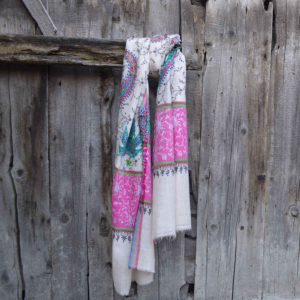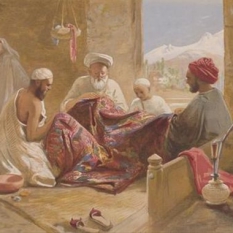
The word Kashmir Pashmina refers to the fabric woven out of Pashm by the crafts person from Kashmir following the traditional methods that has evolved for more than 600 years. Centuries ago the Kashmiris discovered the warm, soft fleece of the Pashmina goat and began spinning it by hand into yarn. The yarn was then woven on looms and thus pashmina shawl was born. Ever since pashmina has been made in the kashmir valley. Pashmina is derived from the word Pashm Which is Persian for the word wool.Pashm is the downy undercoat of the Himaliyan mountain goat capra hiracus which survives at an elevation of 4500 metres where temperatures rarely rise above minus 40 degree centigrade in winter and in order to survive these harsh conditions these goats produce one of the finest, softest and warmest wool available in the world.
Pashmina by the blossoms of heaven is the finest quality of Pashm,with a diameter of 12.5 to 16 microns, coming from the finest specie of himaliyan mountain goats . These goats are reared by the herders from the changpa tribe.The Changpa are nomadic pastoralists, whose tents are scattered throughout Tibetan and Ladakhi Changtahng, a vast and complex terrain of flat expanses of land interspersed by mountains and valleys. For centuries these have lived in this bleak high altitude landscape, herding the goats whose Pashm supplies the Kashmir shawl industry. In late spring , these nomadic shepherds comb their goats with a special comb to ensure that the fibre is not broken nand collect the fleece. This Pashm fibre is then brought by Ladakhi traders where Kashmiri people make their purchase. These Kashmiri people take this Pashm to Kashmir where it goes through the traditional process of hand spinning and weaving. The pure Pashm is so fine and delicate that it can only be hand spun and hand woven into fabric.
History Of Pashmina

The art of making Pashmina is believed to be as old as 2000 years B.C. Kashmir Pashmina spells romance and for centuries now, Pashmina has been woven into shawls and worn by the most powerful people of the ancient civilizations. The history of PASHMINA is very interesting and old. Uniqueness of Pashmina becomes possible due to historical conditions prevailing in Kashmir after the 14th century. The soft, intricately made cloth have found favour the kings, emperors, and the aristocracy, which is why this fabric came to be known as the fibre for kings. The wearing of the shawls was introduced into the valley from Turkistan by Zain-Ul-Abdin, then ruler of Kashmir in the 1400s. The ancestors of the Nepalese were the first who perfected the skill of retrieving Pashmina of up to about 95% purity. This skill was passed from generation to generation as a heritage of Nepalese artistry and ingenuity. In fact, Kashmir, from where the Pashmina originated, has always been famous for its craftsmanship. For a long time, Kashmir was the only place the fibre could be woven into shawls because of the treaties which gave the Maharaja of Kashmir the sole right over Tibet’s Pashmina supply. This allowed the cottage industry and art of Pashmina-making to flourish even more. Production also benefited from the patronage of the Mughal rulers like Akbar and his successors. There is unanimity among the historians that development of arts and crafts took a new turn in Kashmir after the fall of Hindu Dynasty (1320A.D) and with the advent of Islam in Kashmir.The famous Sufi saint of Persia Mir Saied Ali Hamdani who came to Kashmir in 1378 A.D with highly skilled artisans and laid base for the cottage industries in Kashmir valley.
Making Of Pashmina
The making of Kashmir Pashmina at Blossoms Of Heaven involves these stages, all done by Kashmiri artisans having proficiency in their respective areas.
Procuring the Pashm wool: We at Blossoms Of Heaven procure Pashm directlty from Changpa tribe in Ladakh, who rear domesticated goats called Capra Hiracus in high altitude pastures of Western Himalayas, including the contiguous South Eastern Ladakh. The tribe collects raw pashm manually by combing these goats. Sometimes these goats shed their coat by rubbing against rocks and bushes.
Preparing the Pashm wool: The raw Pashm procured from Ladakh is greasy, lumpy, discolored wool mixed with strong hairs and many organic impurities like, dung, dirt and even pieces of skin. The women folk who do spinning manually remove all dirt and impurities from raw Pashm before it is spun.
Spinning the yarn: Blossoms Of Heaven is working on sustainable basis with 20 women spinners who are expert in spinning on traditional Charkha called Yeinder. A cleaned lump of Pashm is manipulated by the fingers of the left hand while the right hand is used to turn the Yeinder smoothly. The yarn thus prepared gets automatically wound around a detachable length of straw enclosed around the iron spindle. Arranging the warp: Before weaving would actually commence, Blossoms Of Heaven gives yarn to warpers, dressers and reelers . Each of these artisans process yarn manually till warp is ready to be installed on loom.
Weaving of fabric: The in-house Weavers at Blossoms Of Heaven prepare a loom for Pashmina weaving. The entire process of weaving is by hand on basic type of foot loom setup on a wooden frame work, with a bench for a weaver. It has a warp beam, heddles and comb suspended from the top. This traditional loom works on the throw and catch movement of the shuttle back and forth across the warp. The wooden comb is brought down heavily to push the wool into place after each line of Warp is woven.
Clipping the loose threads: Pashmina thus woven in the manner described above is sent to the Purzgar the clipper, whose role is to free them from disordered hairs or yarn and nips mixed with the threads during spinning. He also removes loose ends and knots with perfection. Purzgar employs a pair of large pincers moving it rhythmically over the fabric in a clipping action.
Dyeing: The woven yardage is given to the Rangrez, dyer to be dyed according to the requirements of the end product. Blossoms Of Heaven ensures that each product is dyed with Azo free dyes to ensure international quality standards. The dyer at Blossoms Of Heaven is proficient in dyeing yarn and fabric with various brilliant colors and tints of permanent nature.
Washing and Packing: Finally finished Pashmina product is sent to a washer man who is specialized in shawl washing. He washes it very cautiously with locally manufactured caustic free soap. Each product washed is checked thoroughly by quality control team at Blossoms Of Heaven to ensure product quality is as per desired specific quality standards.



